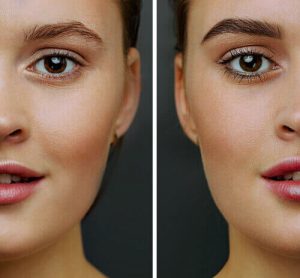
There are two general after-care methods when it comes to Microblading: Dry-Healing and Wet-Healing. It really depends on the artist and what they think is best for you.
Dry Healing
It’s how PMU artists have directed aftercare for their clients, and how some still do today. Dry Healing is exactly how it sounds. This means that you CANNOT get your brows wet AKA sweat or work-out for at least 7-10 days. The goal here is to let your eyebrows heal on their own with no assistance. This product-free approach has been adopted by many PMU artists out of concern that applying products can “pull out or wash away” the pigments. What some artists forget to explain is the biology of skin during the healing process. Scabs form, they get dry and crack and may even expand the wound causing more healing tissue to form. Scabs are susceptible to being caught in fibres such as cotton q-tips etc and there is a risk of tearing or further damaging the area. As the wound dries out it can create more irritation, causing that area to feel itchy. The skin will eventually heal on its own as long as the area continues to be kept clean with a gentle and fragrance-free soap.
PROS: There’s nothing for you to do and no aftercare kit required.
CONS: Not only is this a myth (your tattoo could wash away!), but it is NOT hygienic and NOT recommended. If there is no cleansing, the area can collect bacteria and debris (think thick buildup of yellow, crusty scabs), which may extend your healing time, or worse, infection. In the end, you’ll have heavy scabbing during healing and you’ll lose more color.
Wet Healing
Wet healing is how most PMU artists have their client’s heal today. This method refers to gentle cleansing with light application of a healing ointment to the tattooed skin, meaning the skin will be kept “wet” during the initial stage of healing to prevent bacterial buildup,, think hydrated. Product is added to the skin to provide hydration to aid in rebuilding new cells. When applying product during “wet” healing, the key is to apply only a very THIN layer of product into the skin. Wounds need oxygen to heal and suffocating the skin with a thick layer of product may prevent the skin from breathing therefore further delaying your healing time.
You’ll also be asked to clean your eyebrows morning and evening with a gentle and fragrance-free cleanser and told to use the right after-care product to prevent your skin from drying out. Do not use petroleum jelly or polysporin.
PROS: You’ll have minimum to no scabbing and your color will heal much more evenly. You’ll also be given an aftercare kit.
CONS: You’ll have some after-care maintenance to upkeep for at least 7-10 days.
Dry healing is still a common aftercare method even though wet healing has been proven to have the most promising healed results. Make sure to speak with your artist about their healing method. Proper healing is a crucial aspect to your microblading results. Misinformation can result in a poor healing experience.
Image Source: https://bit.ly/3mjzsbB
